Inside art collector Valeria Napoleone’s ‘little Guggenheim’
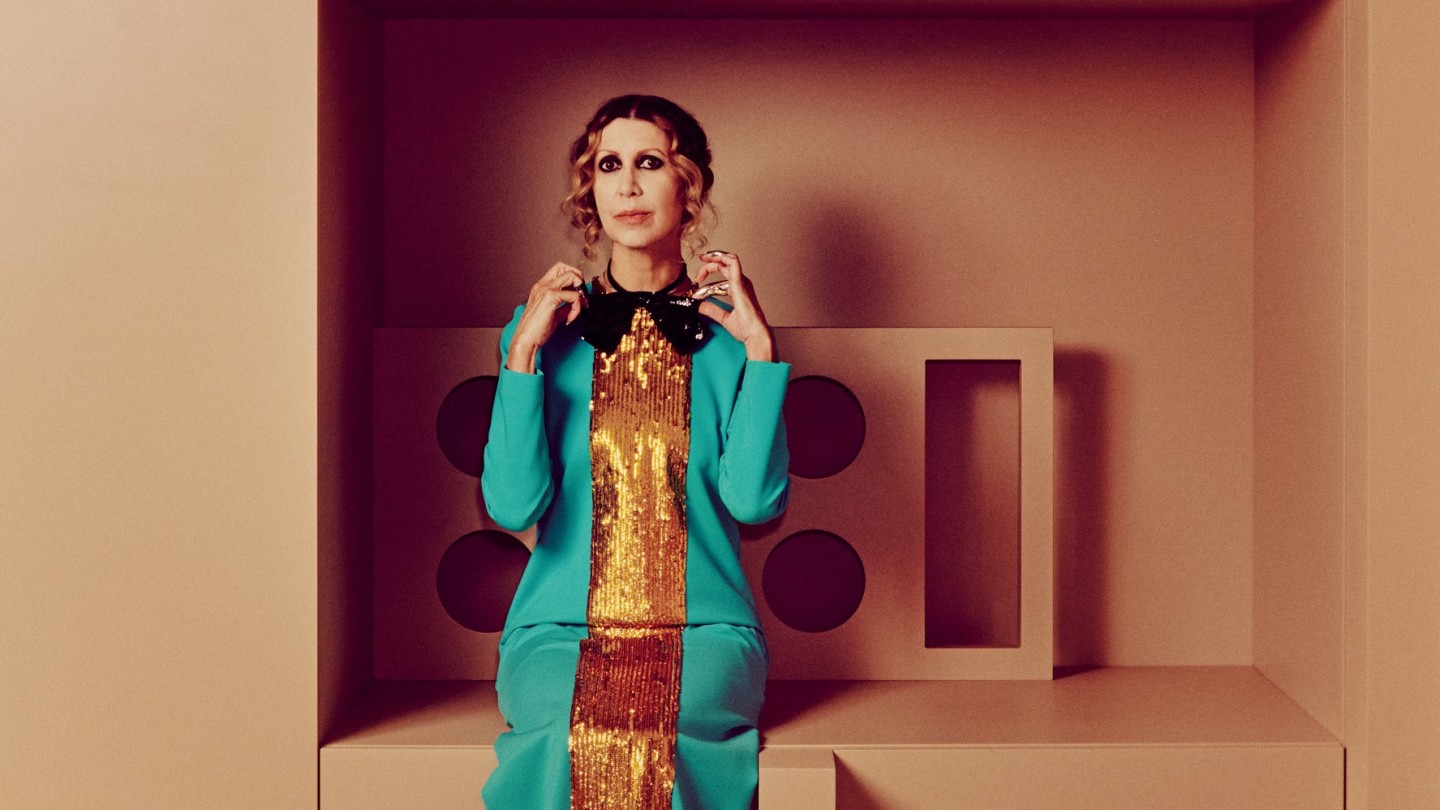
Roula Khalaf, Editor of the FT, selects her favourite stories in this weekly newsletter.
Valeria Napoleone’s gold Prada shoes say a lot. Not so much the low-key slip-ons she is wearing – with patterned palazzo trousers, a hoodie and a baseball cap – when she shows me around her Kensington home. But the freshly unboxed ones with skyscraper platform heels that I spy in her bathroom. They hint at her love of dressing up and entertaining, and her eclectic taste in art and design. As a collector, she only buys the work of women, and has even gone so far as to commission Nathalie du Pasquier, founding member of the ’80s-defining Memphis Group, to create four bespoke pieces for her home.
“In art, but also in design, I like a sense of humour – and playfulness,” says Lombardy-born Napoleone, with an Italian lilt. “I don’t like artists – or people, for that matter – who take themselves too seriously.” Perched upon her voluptuous living-room sofa (a 1970 design by Mario Marenco that was reissued by Arflex in 2018), her long-limbed frame is backlit by an elegantly oversized Victorian bay window and overshadowed by a neon explosion of a painting titled Birth of the Universe – its crude, graffiti-like depictions of male and female genitalia conceived by 79-year-old New York artist Judith Bernstein. “It’s just perfect here,” says Napoleone of the feminist artwork that fills the entire wall.
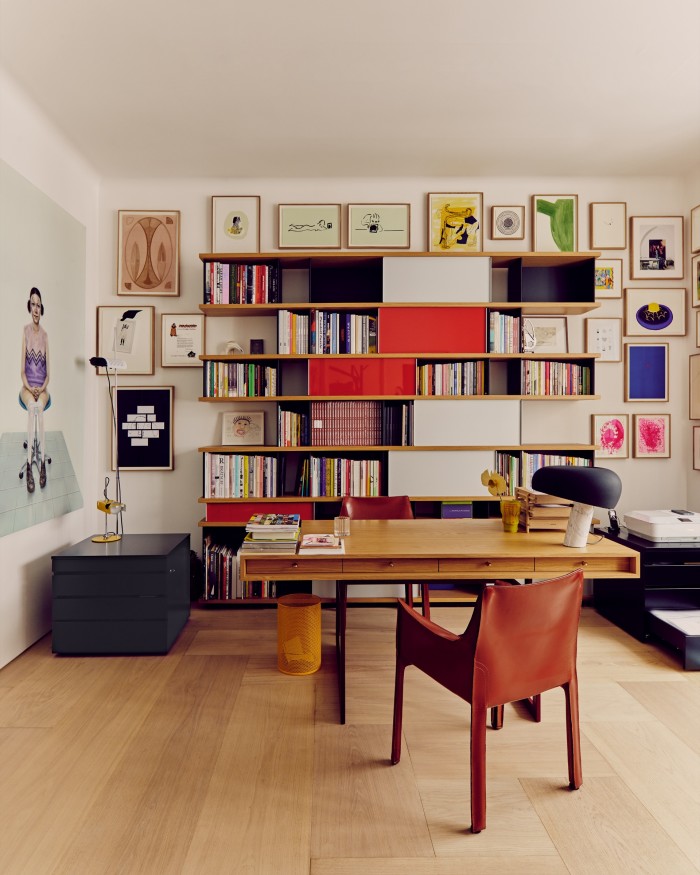

Napoleone started her collection more than 20 years ago, after studying a master’s degree in art-gallery administration at the Fashion Institute of Technology in New York. “It’s a machine that goes on and on and on,” she says. “It’s difficult to stop.” The daughter of a wealthy Italian industrialist – whose company produced plastic resins – to date she has amassed around 450 works. “It was something that came to me very naturally,” she says of the female focus. “The mid-’90s in New York City were really quite magical for contemporary art. There was a lot going on, especially with women artists like Cindy Sherman; they were developing incredible work and creating new languages. And yet I was very much aware of women not being represented in galleries. So I said to myself, ‘I’m going to create a choir of female voices who have been silenced throughout art history.’ That was the start of the journey, and here I am.”
“Here” is a seven-storey Victorian townhouse that Napoleone shares with her husband Gregorio – a founding partner of private equity firm Stirling Square Capital Partners – and their three children. Her daughter Letizia, who has Down’s syndrome, is an advocate for diversity and inclusivity, represented by Zebedee talent agency. Her two sons are both currently studying overseas at NYU. They moved into the space – from an apartment across the road – this time last year, following a three-year renovation undertaken by London’s Quinn Architects and Milan’s Studio Monzini & Raboni. The all‑white walls, grey stone and wooden floors, and steel‑framed glass partitions create an elegant, thoughtful backdrop to the house’s main focus: the vibrant art and design. “My intention was really to accommodate the art as if it’s another one of my children,” smiles Napoleone. “I want to honour my most beloved pieces while keeping the balance of a home.”
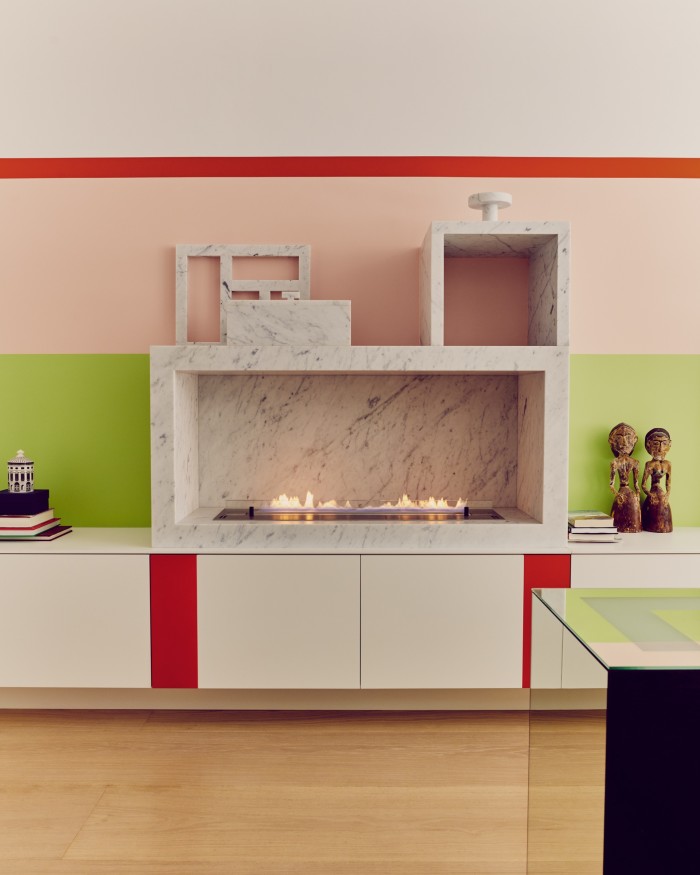
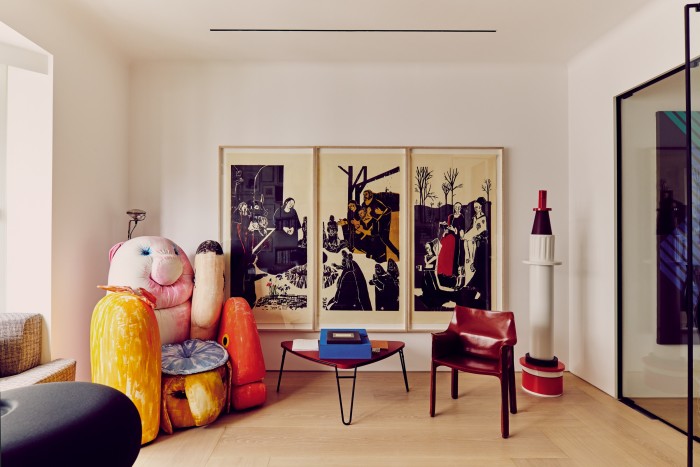
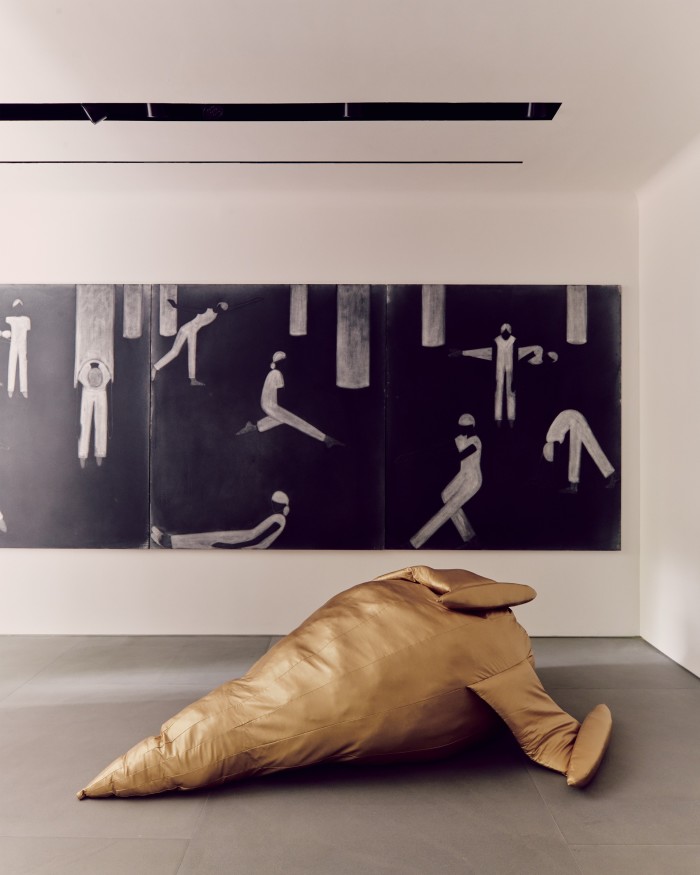
Du Pasquier has contributed to this balance with four interventions to the fabric of the house. Her approach to art has long been admired by Napoleone, who purchased one of her tall, ceramic, totem-like sculptures just before embarking on this collaboration. “I didn’t know what I wanted her to do, but I just called her gallery and said I would like to do a project with Nathalie in my house.”
Napoleone gave du Pasquier creative free rein. “Nathalie just came up with the designs and I loved them. Everything she does is so beautiful,” she says of the 64-year-old Milan-based artist whose paintings on paper and canvas blur the boundaries between the work and the space around it. In fact, she’s used the same chunky abstract shapes that appear in her recent paintings to create a wall cabinet in the master bedroom that incorporates a marble fireplace as well as a surrounding wall painting. “I told Nathalie just to give me the colours, because they must be her colours,” recalls Napoleone, who also suggested a bespoke design for the master bathroom to counteract the otherwise austere, grey space. “I thought it would be incredible to have something really whimsical and colourful,” she says of the vanity area, clad in handmade baby-blue tiles and topped with piston-like ceramic sculptures. “The mirror cabinet has a really beautiful interior too,” says Napoleone, opening the doors to the unit to reveal a painted wood surface in bright orange.
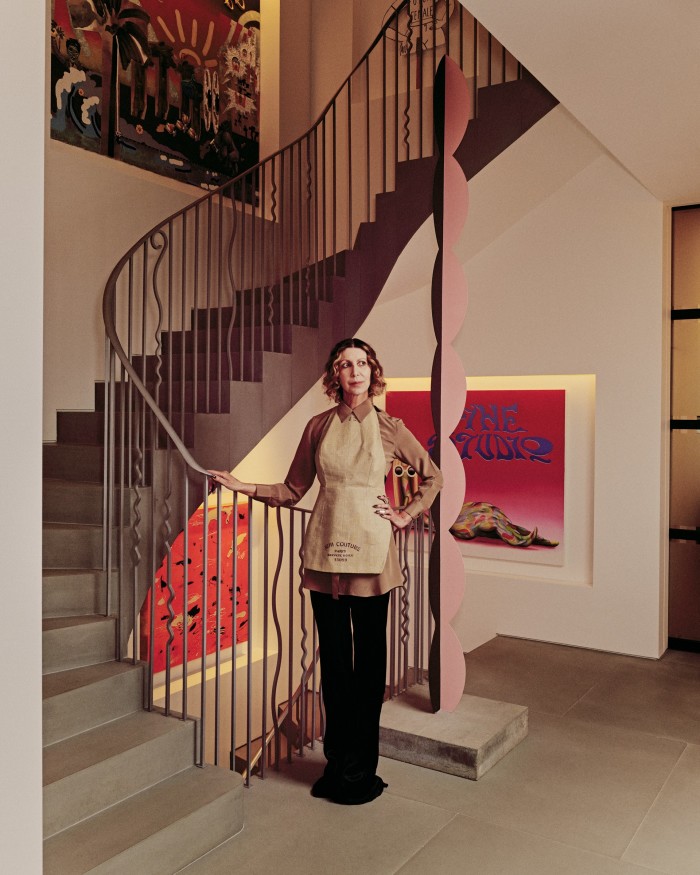
Du Pasquier’s is not the only work in this space. Another focal point is created by a large, lacquered mirror – a 1980s piece by Nanda Vigo, which is shaped to obscure reflection. “Vigo was the companion of Italian artist Piero Manzoni,” Napoleone explains. “She was marginalised in everything she did but, finally, received a lot of attention. Like Nathalie, she has a very strong presence in this house.”
Vigo’s work also takes centre stage in the bedroom. Her bed – a 1970s design that never went into production, constructed from mirrors and lit panels – sits in the middle of the room. “I commissioned her to make it before she passed away last year,” Napoleone says. “The bedcover is fake fur because she loved fake fur, but I have to sleep with soft pillows to pad it out a little bit, because it’s actually quite dangerous with all those sharp corners and glass.”
Spotting the iconic furniture of female designers is possible in nearly every room: there are several Charlotte Perriand designs, including a set of nesting Petalo tables in the living room, a Tokyo chaise longue in the bathroom and a Nuage bookcase in the study. “My desk is called the most beautiful desk in the world – it was in the James Bond movies,” says Napoleone of the re-edition of the design by Danish architect Bodil Kjær. In the kitchen, the lamps above the table are by New Zealand artist Francis Upritchard (whose husband, Martino Gamper, designed the kitchen itself) while the cinema room is furnished with Patricia Urquiola’s modular Tufty-Time sofa.
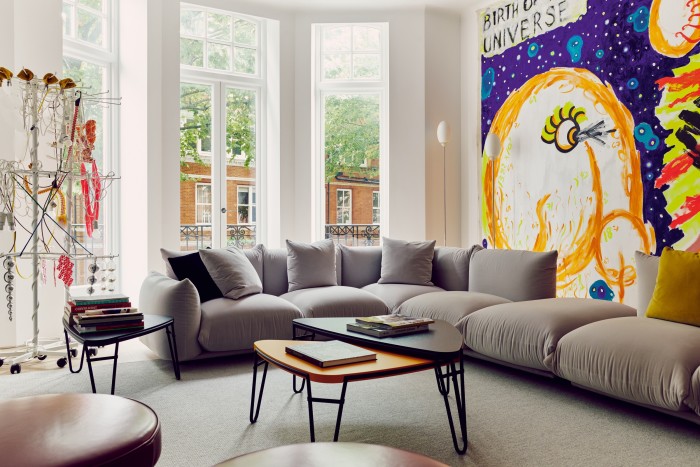
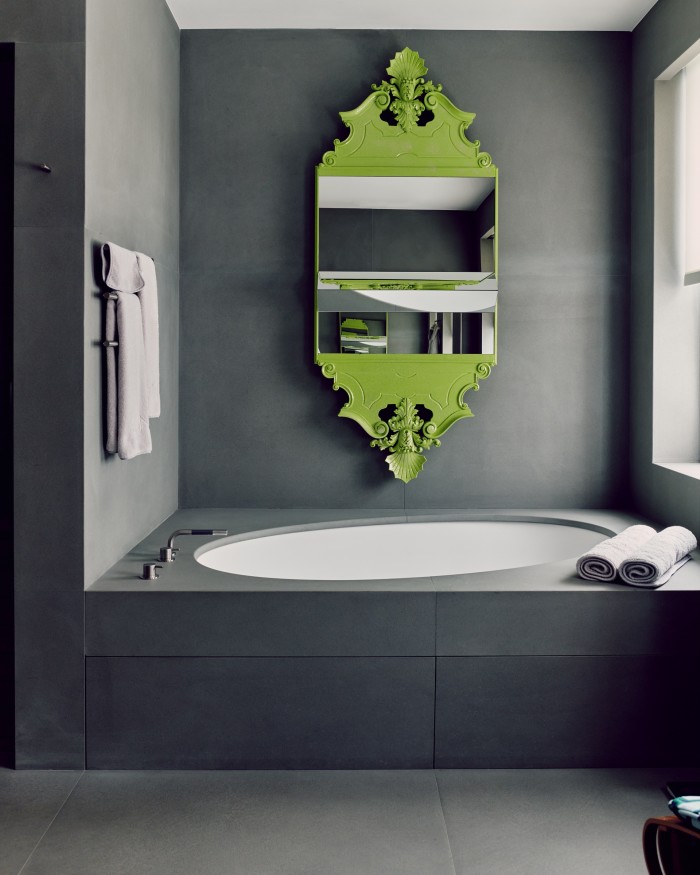
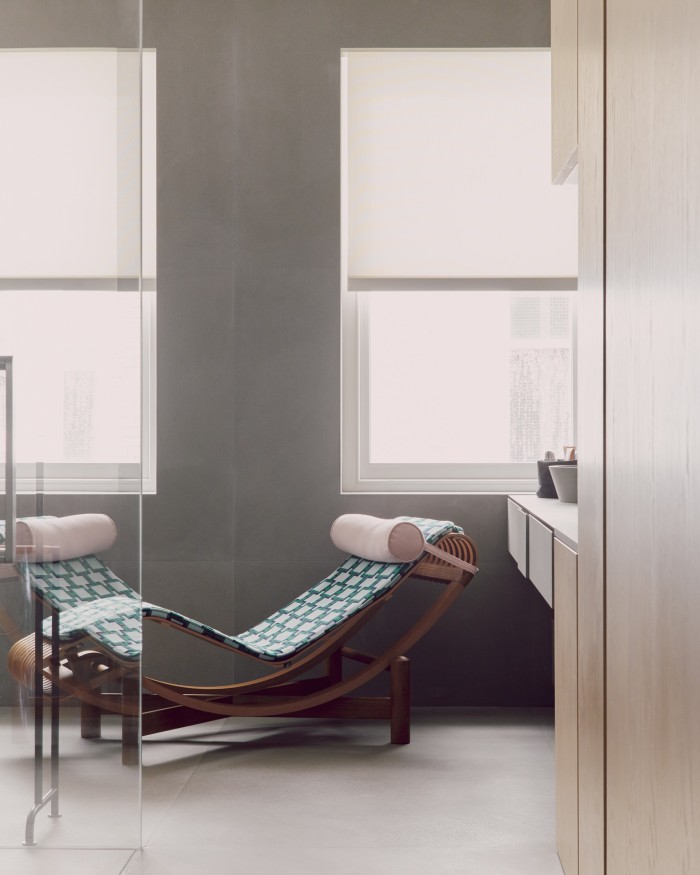
For du Pasquier, the allure of being part of this roll-call was the chance to do something different. “As an artist I’m interested in constructing geometric compositions as installations, but this was the first time I have designed elements for a specific house,” she says, pointing out the giant wall unit in the dining room, a bold geometric design in a single, uncharacteristically muted tone.
“We were planning to do a cabinet in all the colours – red, green, blue, black – that are typical of Nathalie but then we saw it in raw wood and loved it,” says Napoleone. “It’s so elegant, and very unusual for Nathalie,” she adds of the piece, which Milanese architect Giuseppe Raboni produced with an all-Italian team of artisans, working to realise du Pasquier’s hand-drawn sketches. Her playful style comes through in the oversized proportions – “The handles are huge,” says Napoleone – and its cleverly concealed storage. “It’s very functional,” she adds, pointing to a wine fridge, ice-maker and a dumb waiter (connected to the kitchen) hidden within.

Indeed Napoleone, a consummate host well known for her art-world soirées, has designed this house for entertaining. “Over the past 20 years I’ve hosted so many dinners, probably six or seven a year, for around 100 people.” These parties had, of course, been on hold since moving into their townhouse this time last year. But the philanthropist has just thrown open the doors to her new home for its first big party: a celebration of Rindon Johnson, a 31-year-old American artist whose first UK solo show opened at east London’s Chisenhale Gallery earlier this month. “The dinners always serve a purpose, but they are really fun, too – they nurture me,” she says. “As a collector, I love to share, it’s in my DNA. The purpose of this home is also that of patronage.”
As well as supporting female artists by buying their work and loaning it (two of her pieces are currently in the Hayward Gallery show Mixing It Up: Painting Today), Napoleone has cemented her philanthropy into a platform she calls Valeria Napoleone XX. She has founded initiatives at New York’s SculptureCenter and Institute of Fine Arts, and partnered with the Contemporary Art Society in the UK to donate works by female artists to regional museums. “Valeria wanted to increase awareness of the gender imbalance in public collections and do something about it,” says CAS director Caroline Douglas. “She’s very engaged in her approach, and incredibly committed.”
In Kensington, her patronage is revealed at every turn. In the living room, a sculpture of found objects by South Korean artist Haegue Yang sits opposite her giant genitalia painting. On the landing, a canvas by Bournemouth-born Ndidi Emefiele depicts three individuals on the London Underground (Somebody’s Commute, 2018), while exploring female identity and her Nigerian heritage. There is also a soaring painted-tin sculpture (Kusine, 2005) by German artist Nicole Wermers, its scalloped edge playfully echoing the shaping of the metal balustrade – the spindles breaking into curves and wiggles at indeterminate intervals – and drawing the eye upwards, into the stairwell.
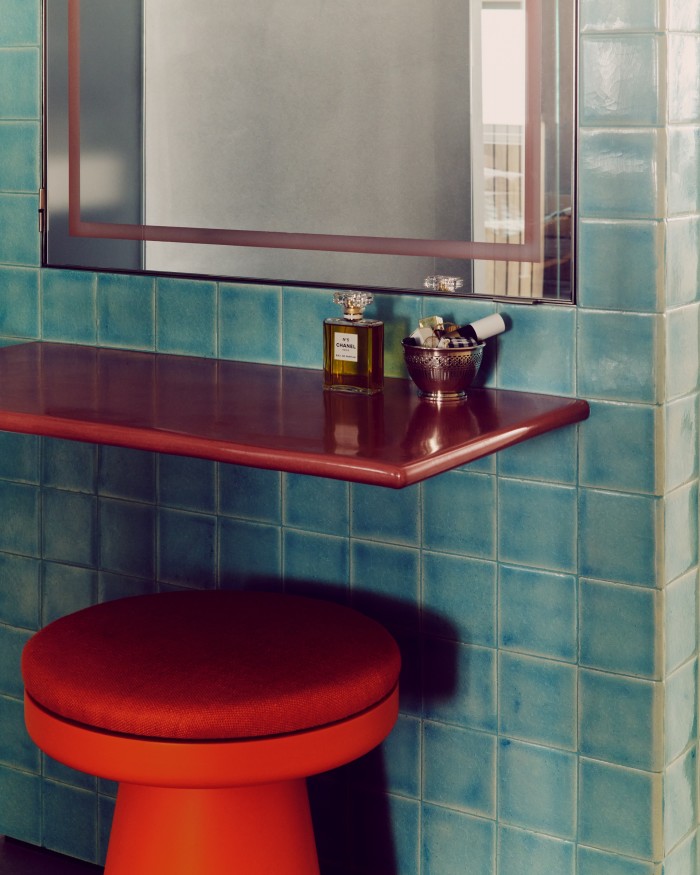
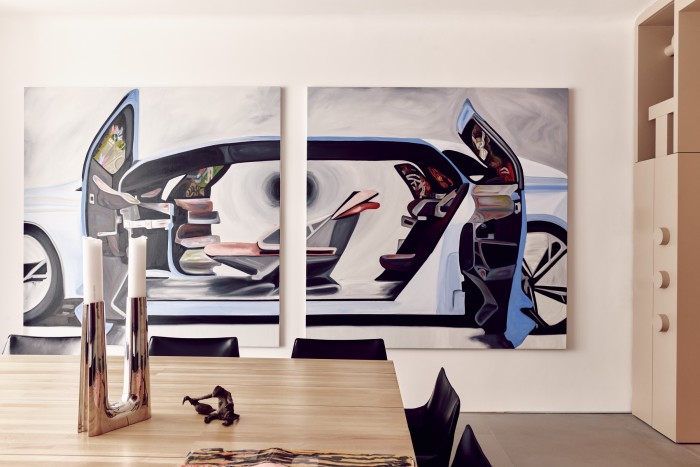
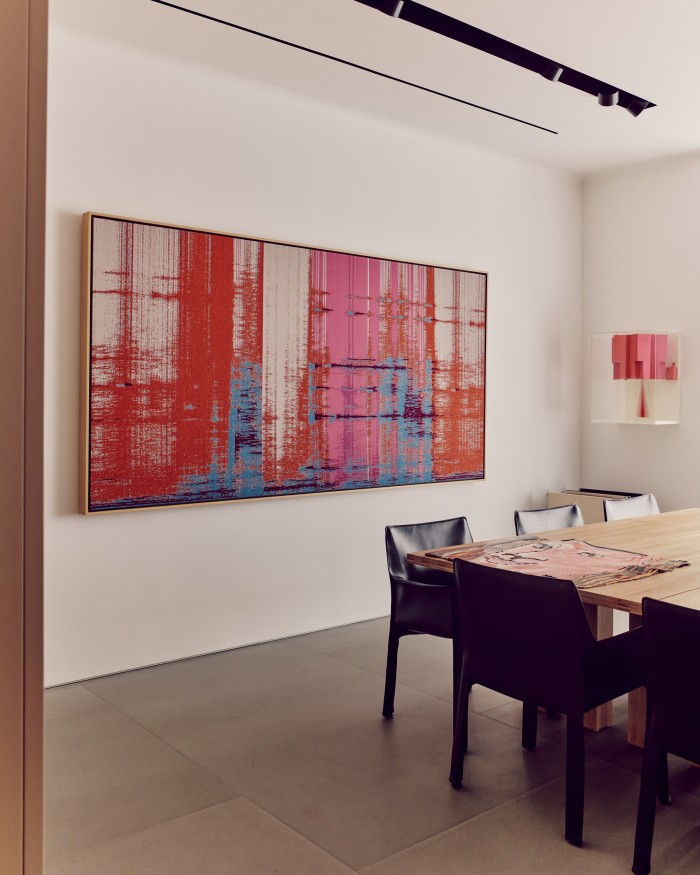
“It’s my little Guggenheim,” says Napoleone, who has set niches into the stairwell walls to showcase paintings or small sculptures. The walk up and down takes in a Frances Stark ink work; “a stitched denim canvas with breasts”, by Monika Baer, one of Napoleone’s favourite artists; and a placard from the Women’s March on Washington in 2017, which reads “The Future is Female” and is the work of 32-year-old New York artist Grace Weaver.
Napoleone admits to a unifying theme to her collection. “Each piece gives me some sort of uncomfortable feeling,” she says, giving the example of Margherita Manzelli, whose 1998 painting Neobros was one of her earliest acquisitions. “When I first saw this piece, it really disturbed me,” she says of the pastel-hued portrait of a woman with her tights around her knees. “She does some really tough work, but at the same time it’s so incredibly beautiful. If it feels uncomfortable, that’s a good sign. It’s opening doors and pushing your brain.”
Napoleone is contemplative about the influence her collection has had on her own children. “I hope that what they’ve learnt from being surrounded by so many creative minds and free spirits is that you can go your own way, you don’t need to fit into anybody else’s shoes.” You can, of course, wear giant gold platforms instead.
Comments